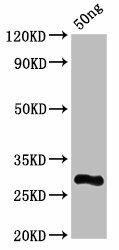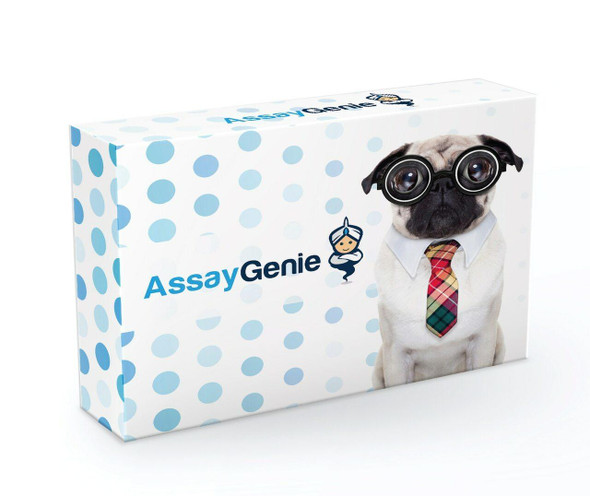Description
| Antibody Name: | L Antibody (PACO61874) |
| Antibody SKU: | PACO61874 |
| Size: | 50ul |
| Host Species: | Rabbit |
| Tested Applications: | ELISA, WB |
| Recommended Dilutions: | ELISA:1:2000-1:10000, WB:1:500-1:5000 |
| Species Reactivity: | Vesicular stomatitis Indiana virus |
| Immunogen: | Recombinant Vesicular stomatitis Indiana virus RNA-directed RNA polymerase L protein (598-784AA) |
| Form: | Liquid |
| Storage Buffer: | Preservative: 0.03% Proclin 300 Constituents: 50% Glycerol, 0.01M PBS, pH 7.4 |
| Purification Method: | >95%, Protein G purified |
| Clonality: | Polyclonal |
| Isotype: | IgG |
| Conjugate: | Non-conjugated |
 | Western Blot. Positive WB detected in Recombinant protein. All lanes: L antibody at 7µg/ml. Secondary. Goat polyclonal to rabbit IgG at 1/50000 dilution. Predicted band size: 28 kDa. Observed band size: 28 kDa. |
| Background: | RNA-directed RNA polymerase that catalyzes the transcription of viral mRNAs, their capping and polyadenylation. The template is composed of the viral RNA tightly encapsidated by the nucleoprotein (N). The viral polymerase binds to the genomic RNA at the 3' leader promoter, and transcribes subsequently all viral mRNAs with a decreasing efficiency. The first gene is the most transcribed, and the last the least transcribed. The viral phosphoprotein acts as a processivity factor. Capping is concommitant with initiation of mRNA transcription. Indeed, a GDP polyribonucleotidyl transferase (PRNTase) adds the cap structure when the nascent RNA chain length has reached few nucleotides. Ribose 2'-O methylation of viral mRNA cap precedes and facilitates subsequent guanine-N-7 methylation, both acticities being carried by the viral polymerase. Polyadenylation of mRNAs occur by a stuttering mechanism at a slipery stop site present at the end viral genes. After finishing transcription of a mRNA, the polymerase can resume transcription of the downstream gene. |
| Synonyms: | RNA-directed RNA polymerase L (Protein L) (Large structural protein) (Replicase) (Transcriptase) [Includes: RNA-directed RNA polymerase (EC 2.7.7.48); mRNA (guanine-N(7)-)-methyltransferase (EC 2.1.1.56); GDP polyribonucleotidyltransferase (EC 2.7.7.88); Cap-specific mRNA (nucleoside-2'-O-)-methyltransferase 2 (EC 2.1.1.296)], L |
| UniProt Protein Function: | Displays RNA-directed RNA polymerase, mRNA guanylyl transferase, mRNA (guanine-N(7)-)-methyltransferase and poly(A) synthetase activities. The viral mRNA guanylyl transferase displays a different biochemical reaction than the cellular enzyme. The template is composed of the viral RNA tightly encapsidated by the nucleoprotein (N). Functions either as transcriptase or as replicase. The transcriptase synthesizes subsequently five subgenomic RNAs, assuring their capping and polyadenylation by a stuttering mechanism. The replicase mode is dependent on intracellular N protein concentration. In this mode, the polymerase replicates the whole viral genome without recognizing the transcriptional signals (). |
| UniProt Protein Details: | |
| NCBI Summary: | |
| UniProt Code: | Q8B0H0 |
| NCBI GenInfo Identifier: | 81945898 |
| NCBI Gene ID: | |
| NCBI Accession: | Q8B0H0.1 |
| UniProt Secondary Accession: | Q8B0H0 |
| UniProt Related Accession: | Q8B0H0 |
| Molecular Weight: | 25.4 kDa |
| NCBI Full Name: | RNA-directed RNA polymerase L |
| NCBI Synonym Full Names: | |
| NCBI Official Symbol: | |
| NCBI Official Synonym Symbols: | |
| NCBI Protein Information: | |
| UniProt Protein Name: | RNA-directed RNA polymerase L |
| UniProt Synonym Protein Names: | Large structural protein; Replicase; TranscriptaseIncluding the following 3 domains:RNA-directed RNA polymerase (EC:2.7.7.48); mRNA (guanine-N(7)-)-methyltransferase (EC:2.1.1.56); mRNA guanylyltransferase (EC:2.7.7.-) |
| Protein Family: | |
| UniProt Gene Name: | L |
| UniProt Entry Name: | L_VSIVC |






